After the era of Carles Puyol and Gerard Piqué, Sergio Ramos will need a new centre-back partner for Spain with the Euros coming up. While a number of players have been tried out in this role, it seems as though Pau Torres has gained Luis Enrique’s trust and should therefore be Spain’s starting centre-back alongside Ramos for the foreseeable future.
This has happened at club level as well, where Torres has become almost ever-present for Villarreal CF, where he came through the academy. His partnership with Raúl Albiol has been one of the key parts of the team’s success under Unai Emery. His performances have brought rumours of a move to a bigger club next summer – Manchester City and Manchester United were interested in the 24-year-old defender last year, but a transfer did not go through. It would not be a surprise to see Manchester United rekindle their interest, with other clubs in Europe sniffing around as well.
This scout report looks at Torres’ abilities, attributes and playing style, while we also suggest some issues in this tactical analysis piece that must be fixed in order for the Spaniard to go to the absolute top of the game.
Build-up and passing
One of the biggest reasons for the attention around Torres is his exceptional ball-playing ability. Despite being just 24 years old and just his second season as an established first-team player, the Spanish defender is extremely comfortable on the ball and good at running with it and advancing the attack. These are important qualities for a modern centre-back and he has the ability to help his team in their build-up, along with his obvious defensive qualities.
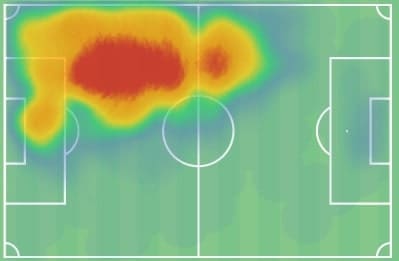
The above image is Torres’ heat map in the 2020/21 campaign. Being a left-sided centre-back, we can see how he primarily affects play on that side of the pitch. However, it is interesting to note how his actions extend into the opposition half as well, showing how he plays a role in the first two phases of his team’s build-up.
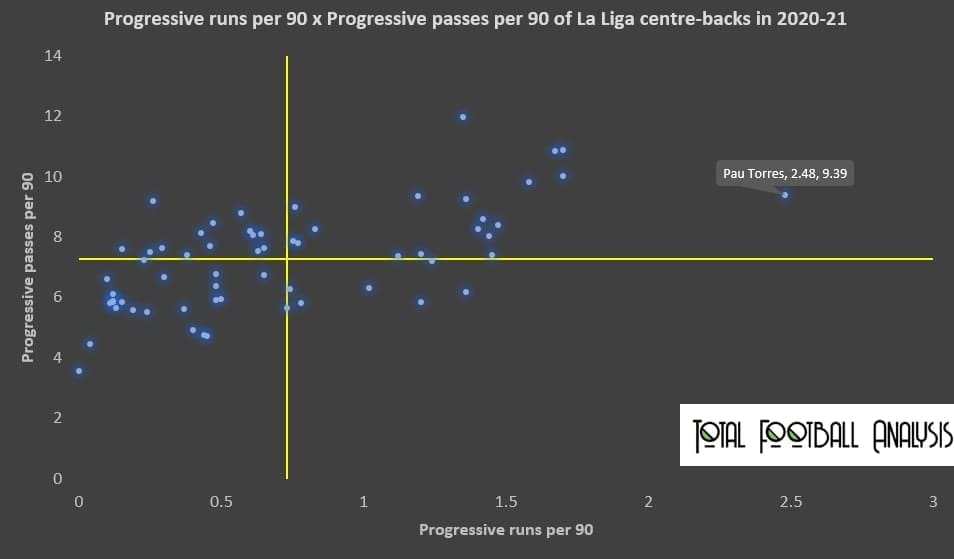
The above scatter chart summarizes progressive passes per 90 and progressive runs per 90 of La Liga centre-backs, to compare their ability to move the ball upfield, as well as the methods they use to do so.
Torres is extremely good at these in terms of numbers. He shows up in the top-right quadrant, which means that he has been better than average for both metrics than the average for La Liga centre-backs this season. He has the highest progressive runs per 90 of these players, with 2.48/90 while he also plays 9.39 progressive passes per 90, which is the 6th best for La Liga centre-backs.
Below we have some in-game examples of how Torres has contributed to Villarreal’s build-up.
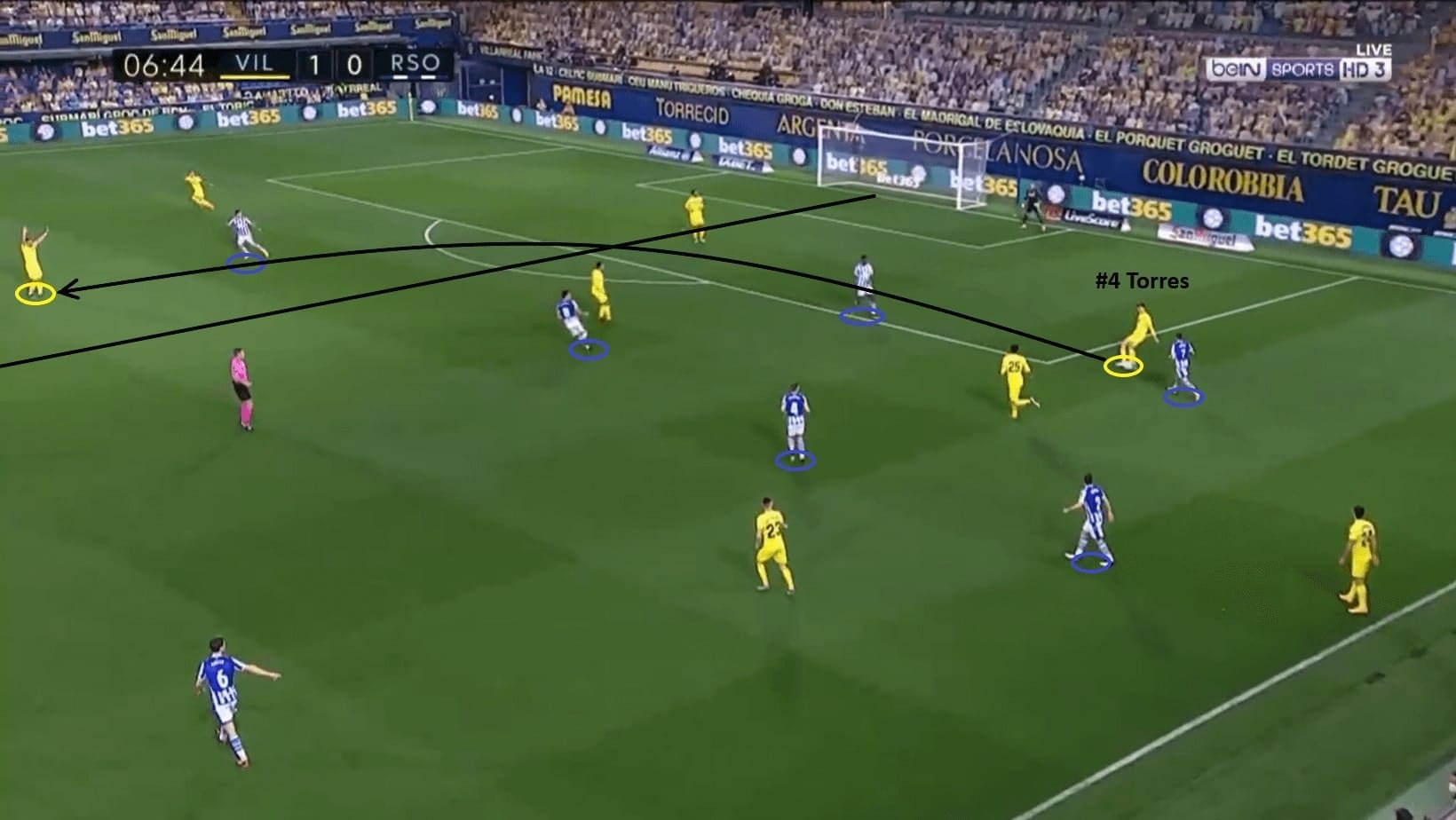
Torres has good vision and passing skills which make him a great asset to the team. He is the main player in the build-up to help Villarreal to break opposition pressing efforts. The 24-year-old centre-back is competent at playing out-balls – the pass that surpasses the pressing players and reaches a teammate behind the opposition’s lines.
The above image shows Torres’ diagonal pass, played to his teammate in the other vertical half. This switch moved the ball to the opposition’s weaker side numerically, allowing his teammates to attack from an area with more space and fewer opponents. The pass eliminated six Real Sociedad players, more than half of their outfield players.
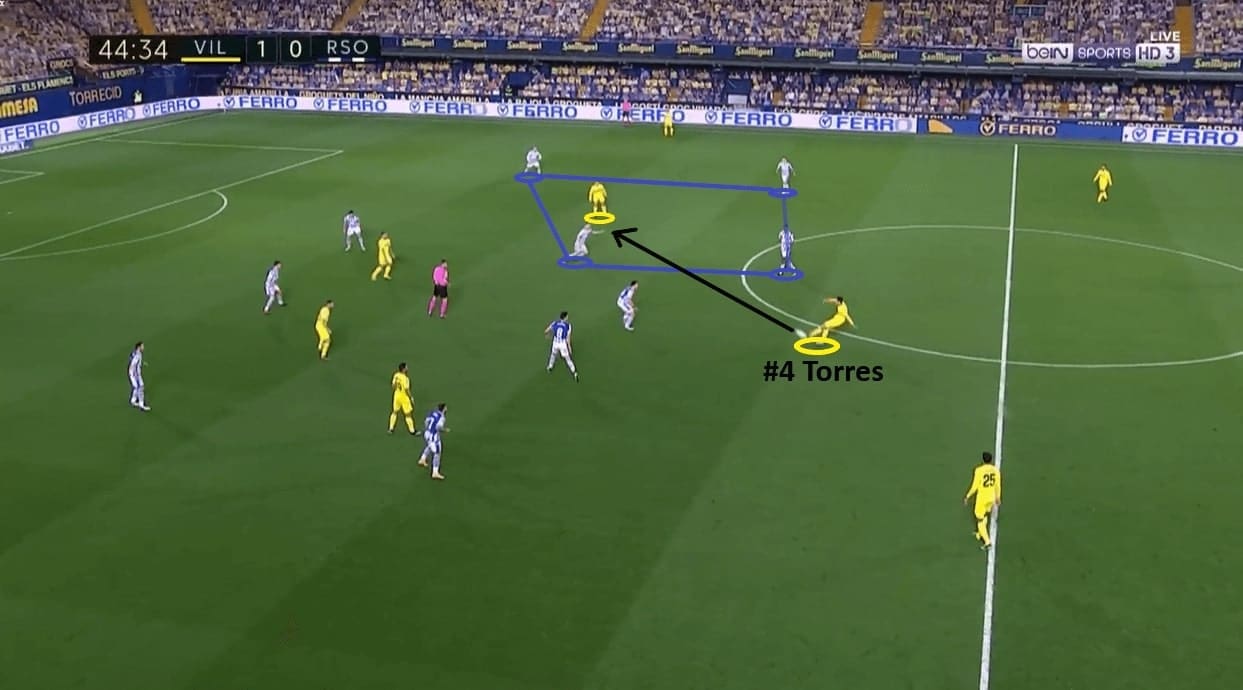
Villarreal are a team that play with a slow tempo, usually trying to pin the opposition in their half, and carefully moving the ball forward by finding players between the lines. This means that they often face a lot of low blocks, since opponents are able to sit back, and therefore Emery’s team usually needs a solution to beat the block.
In the second phase, apart from using Dani Parejo’s ability to break the lines, another key player who organizes attacks is Torres. As shown in our scatter chart, he has more progressive runs than any other centre-backs in La Liga, this is because Emery trusts his ability to bring the ball out and break the first line.
When facing the block, Torres is good at identifying players between the lines – this is a key aspect which allows Villarreal to develop their attack into the final third. Meanwhile, as we have seen earlier as well, the 24-year-old defender is able to switch play with ease, being able to find teammates on the weak side which enables Villarreal to attack space. The above image shows how Torres found his teammate in the right half-space, who had positional superiority.
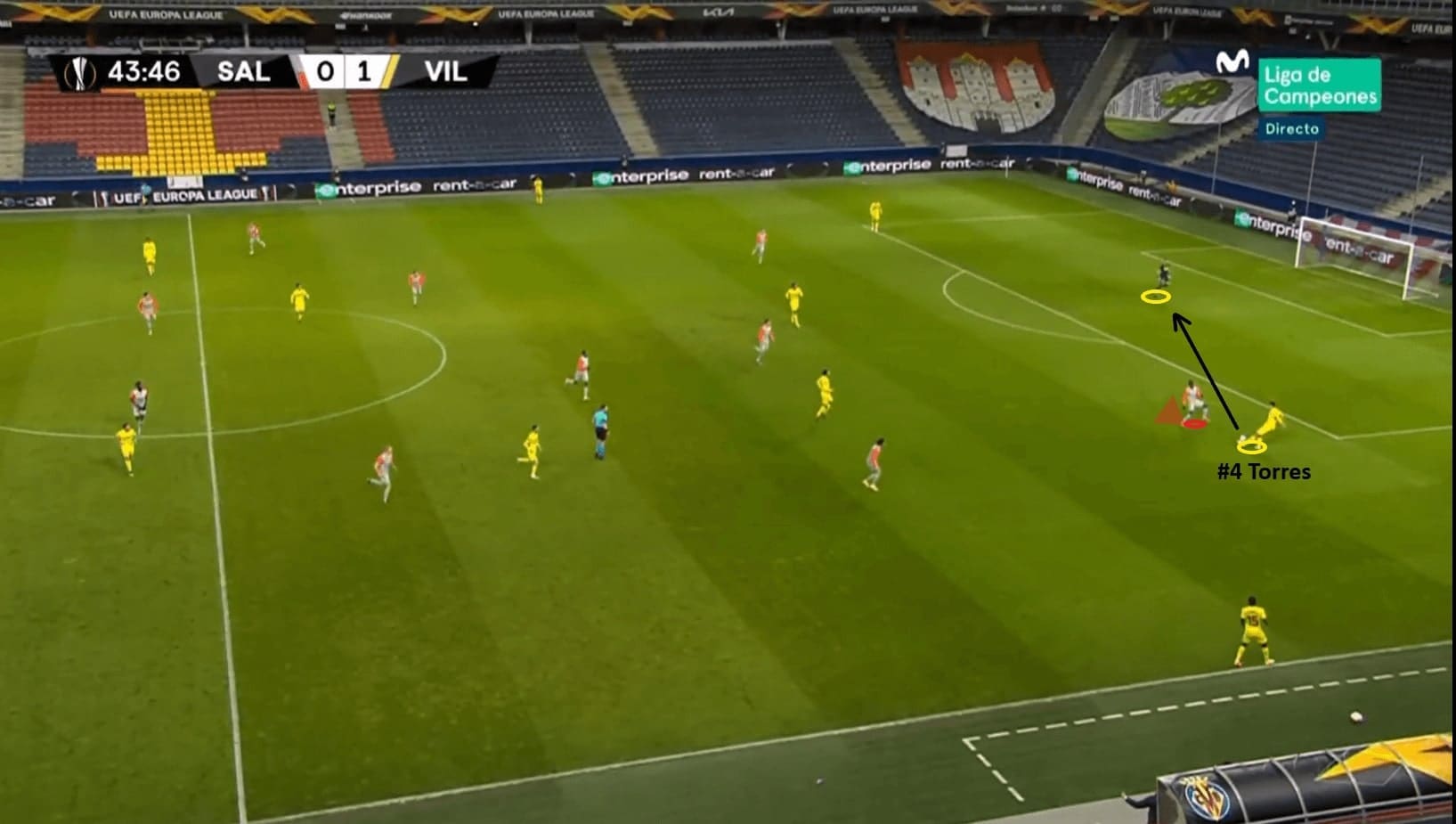
Another promising trait that makes Torres a player with a lot of potential is his ability to play under pressure. When facing teams that press high, his composure and ease on the ball have been vital in the build-up phase.
For example, against RB Salzburg in the UEFA Europa League, Villarreal faced a lot of pressure in the first phase. The opposing striker kept putting pressure on Torres by cutting out the pass to his centre-back partner, pressing him laterally to those passing lanes. Further, RB Salzburg baited Villarreal to pass wide, where they had set pressing traps to try and regain possession in a dangerous area.
However, in general, Torres was able to cope with the high press very well. His quick thinking, passing ability, and confidence helped nullify Salzburg’s press. The image shows how the striker was approaching Torres laterally, closing the passing lane to his fellow centre-back. Additionally, both Villarreal midfielders were surrounded by opponents as well. The wide option was the bait and trap mentioned above. One would think that there are not too many options for Torres here.
However, the Spanish defender surprised the pressing players by returning the ball to the goalkeeper with his first touch. Despite the angle being narrow, as well as limited space and time, he managed to get the timing of the pass right and eliminate the pressing action. By doing this, Villarreal could reorganize their attack in the other vertical half, where RB Salzburg needed time to regroup and press again – crucially, Villarreal had the time to breathe and reset as well, largely due to Torres’ composure and ability on the ball.
Defending
Of course, being a centre-back, his defensive ability needs to be evaluated as well. As we will see further, we believe that it is this side of his game that needs improvement if he is to make the step up to one of Europe’s elite clubs.
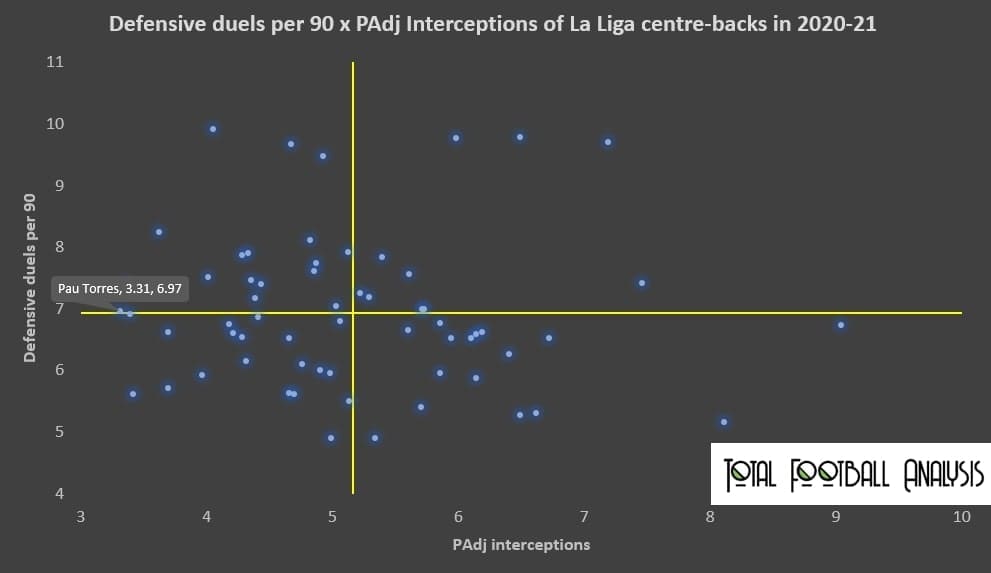
To begin with, this scatter plot looks at defensive duels per 90 and PAdj interceptions per 90 for La Liga centre-backs this season, to gain an idea of the defenders’ style of play.
Torres has not been very impressive in either metric. In terms of defensive duels, he has the lowest number (3.31/90) of all La Liga centre-backs. This might not be a bad thing, as it suggests that Torres is a passive defender, who is not very proactive in engaging with opponents, preferring to stay back and mark the space instead.
However, he is also around the league average for PAdj interceptions, with 6.97/90, which suggests that he is not very proficient at cutting out passes either.
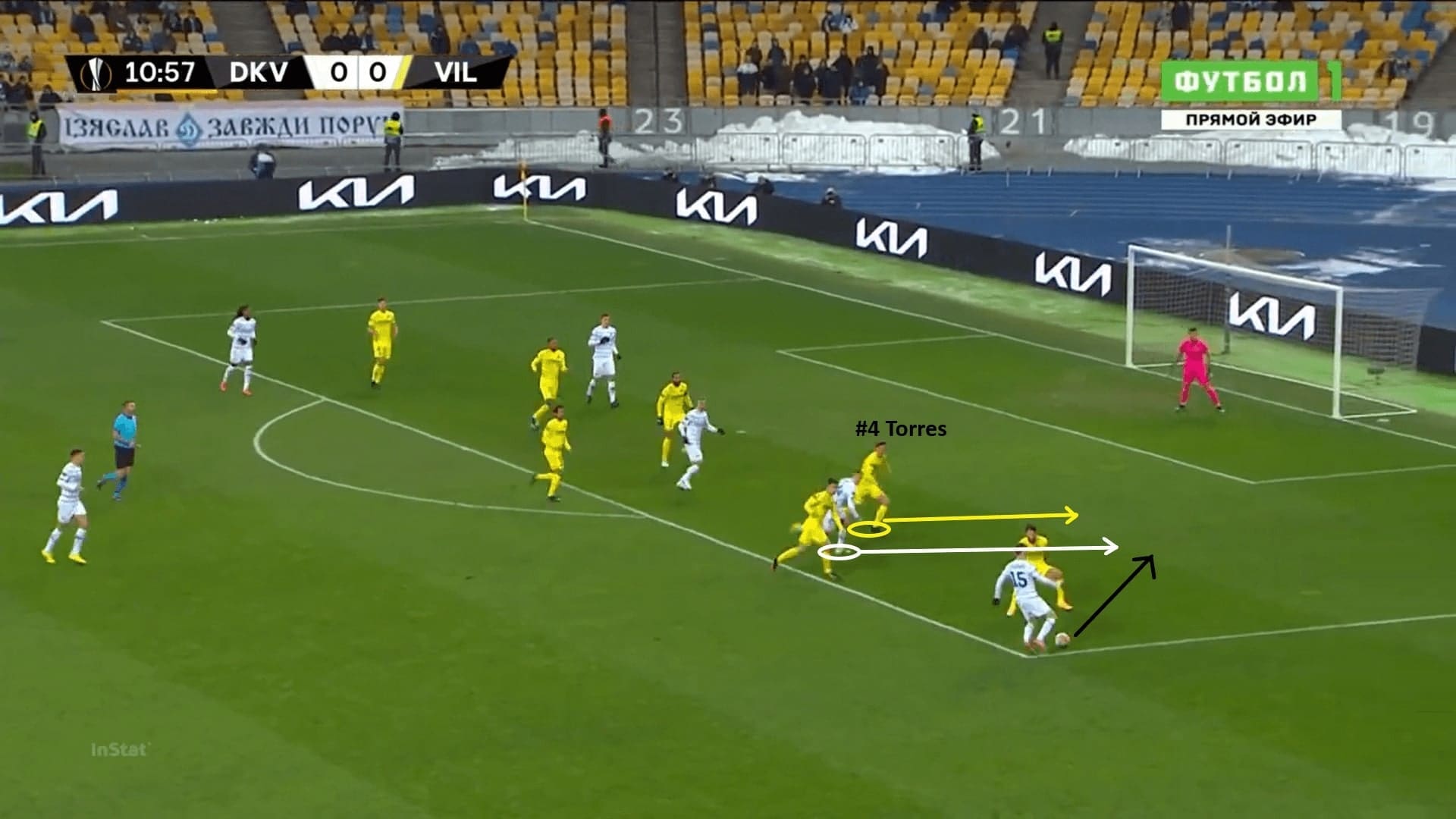
It must be noted that it is extremely difficult to gauge defensive abilities through statistics, as so much ‘good’ defensive work cannot be picked up by the data that we have available to us at the moment. Thus, we will look at some in-game examples which show Torres’ ability, and certain aspects of his game that cannot be quantified.
While not being proactive in challenging opponents, Torres has good awareness to read passes and movements from the opposition. He is able to use his anticipation to cover and block early when defending space behind the Villarreal defensive line.
The example against Dynamo Kyiv shows his strong awareness to recognize his opponent’s run. He spotted the run and began covering immediately, where his speed allowed him to nip in front and regain possession to snuff out a potentially dangerous situation.
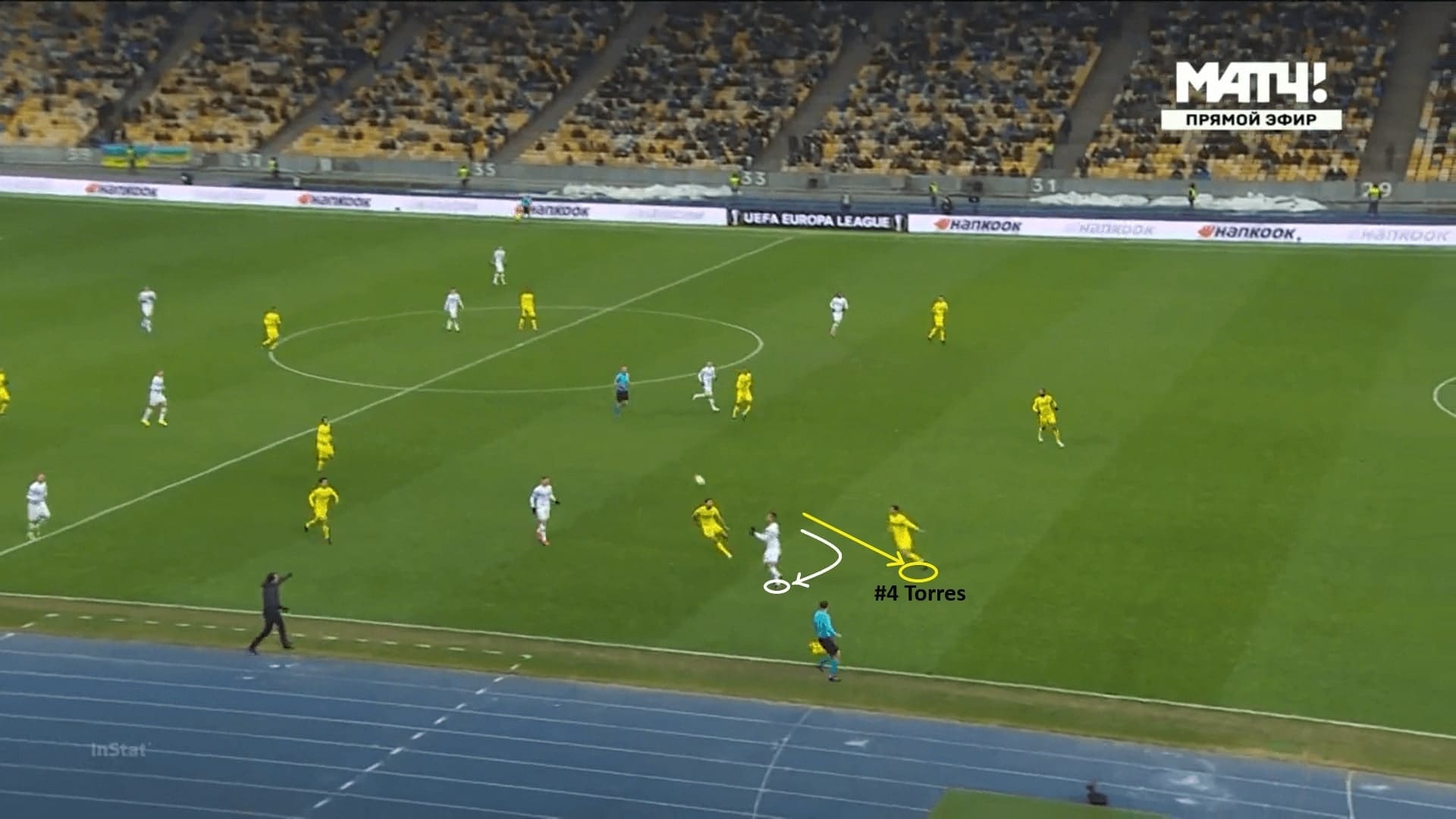
However, Torres’ weakness is while defending space in front of him, particularly against dynamic opponents. He is vulnerable against sharp changes of direction and movement, being caught flat-footed on occasion and struggling against strikers who are constantly making double movements.
For example, the image above shows the situation after the Dynamo Kyiv player initially made a run in behind, before dropping off to receive the pass. The initial run also caused Torres to run back as he often reacts to these sort of runs early, but when the striker suddenly dropped off, Torres failed to react and gave him the space to receive the pass.
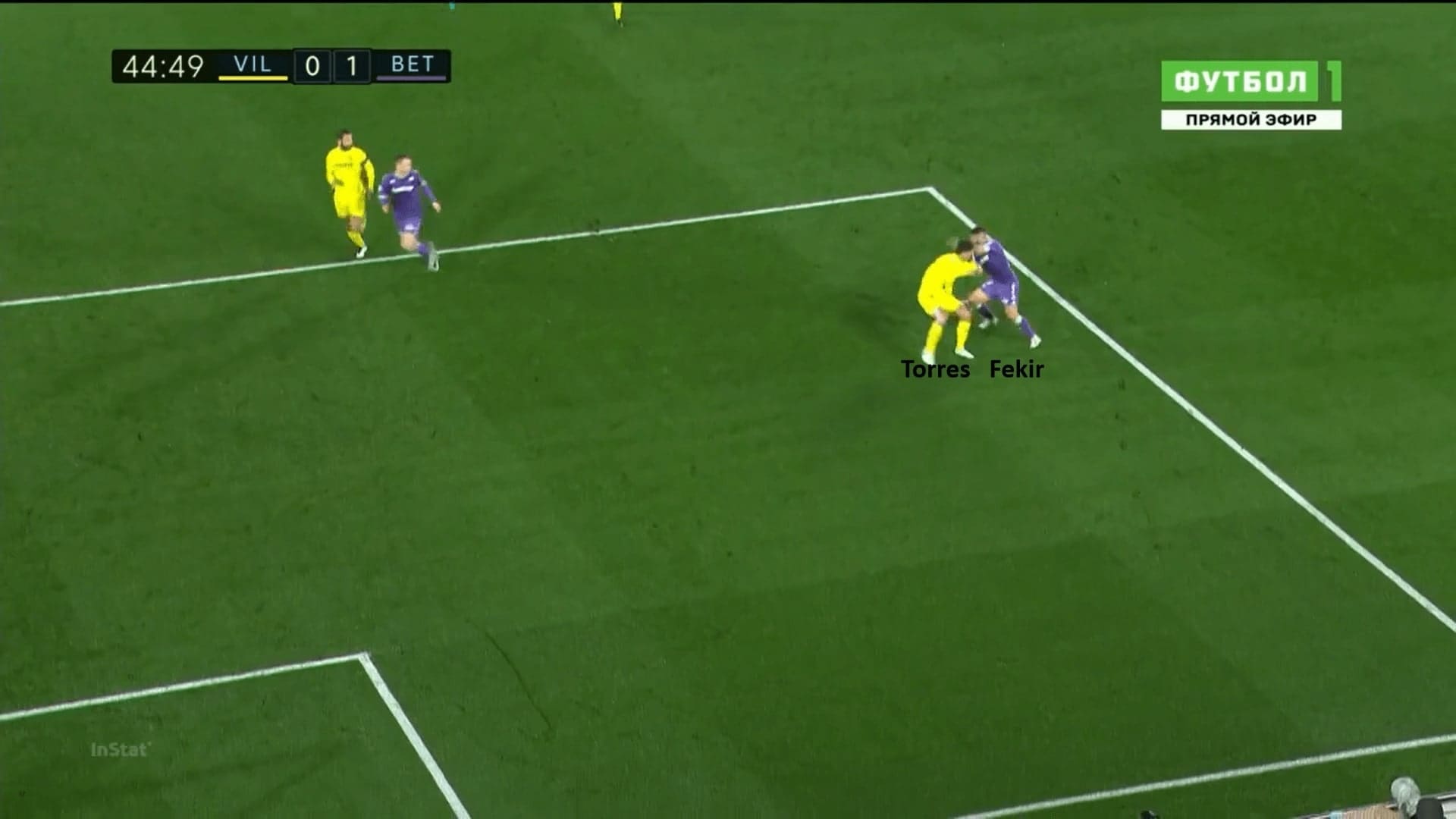
Torres also needs to improve his 1v1 defending, especially in situations where he is with large spaces to defend. This weakness has adversely affected his ability to play in a high line, as well as while defending during transitions.
For example, here he was culpable for allowing Nabil Fekir to get away and score, earlier this season. Torres was quick enough to start his run and track the former Lyon attacker into the penalty box – these are his strengths, as explained earlier. However, he overcommitted, sticking too tight to his opponent. When Fekir suddenly chopped back onto his right foot, Torres was caught wrong-footed and off-balance as suggested in the screenshot above, letting Fekir get away to shoot and score.
The 24-year-old will need to improve his defending in such situations, as he is likely to face these a lot more when playing for a top European team.
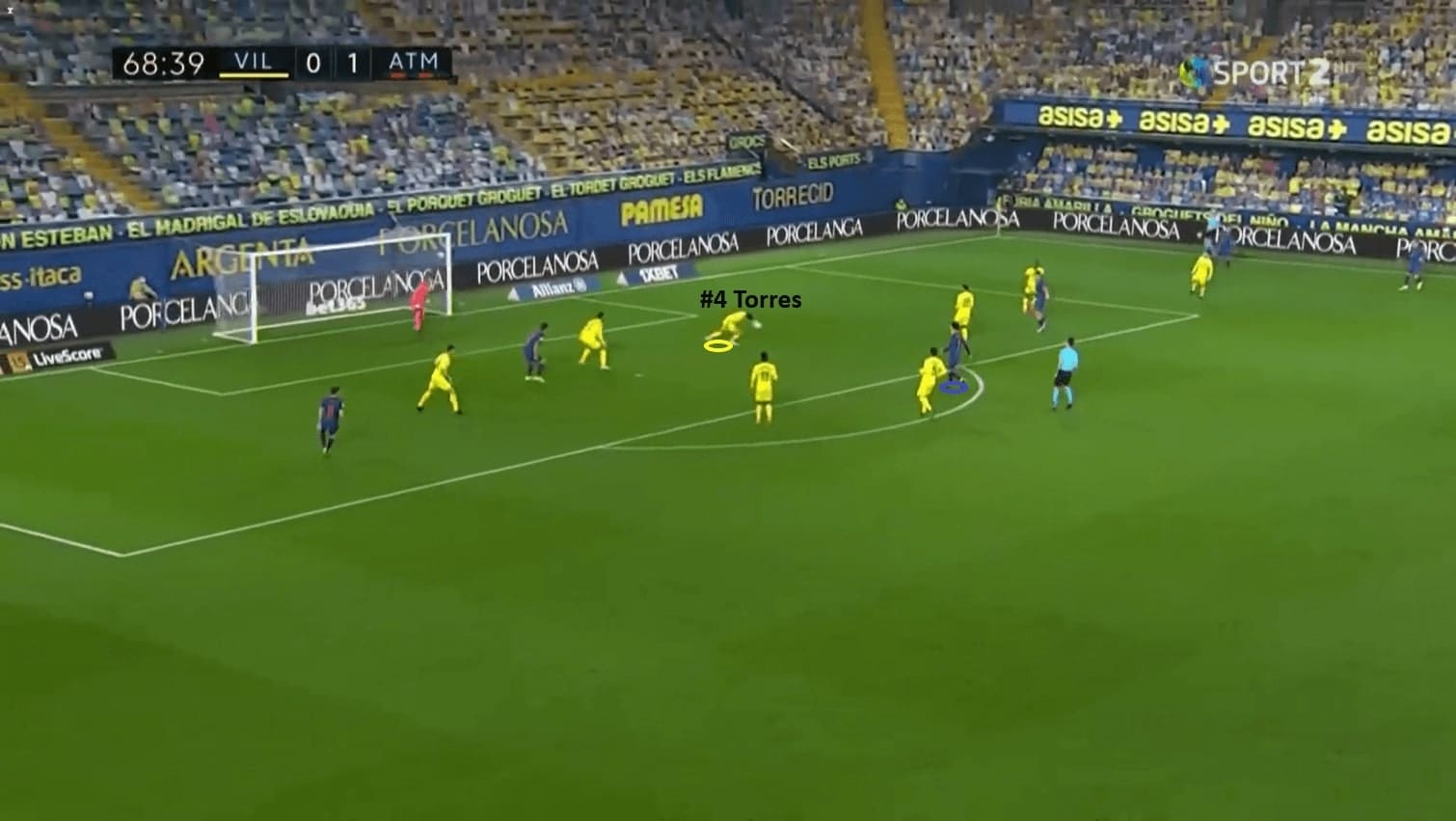
Torres is also prone to making mistakes, which have sometimes been costly. He is not a bad defender by any stretch of the imagination, but sometimes he has given the ball away in critical areas, which has resulted in goals being conceded.
We have shown his error against Atlético Madrid here – facing a cross without any opponent near him, Torres peculiarly tried to head the ball even when it was a slow delivery that he could have easily received at his feet. The resulting clearance was poor, as it just dropped to João Félix who scored with his first touch.
Weakness – high line and the offside trap
We have also separately considered Torres’ performances in a high line and when playing in an offside trap as they are big issues. At the moment, he does not show enough ability in these situations to suggest that he can play in these systems, but he is young enough to learn and improve.
When defending large spaces behind, Torres relies on his strength, which becomes his weakness at times. His decision-making is often questionable, as he often tries to start runs early to chase opponents even when that is not needed.
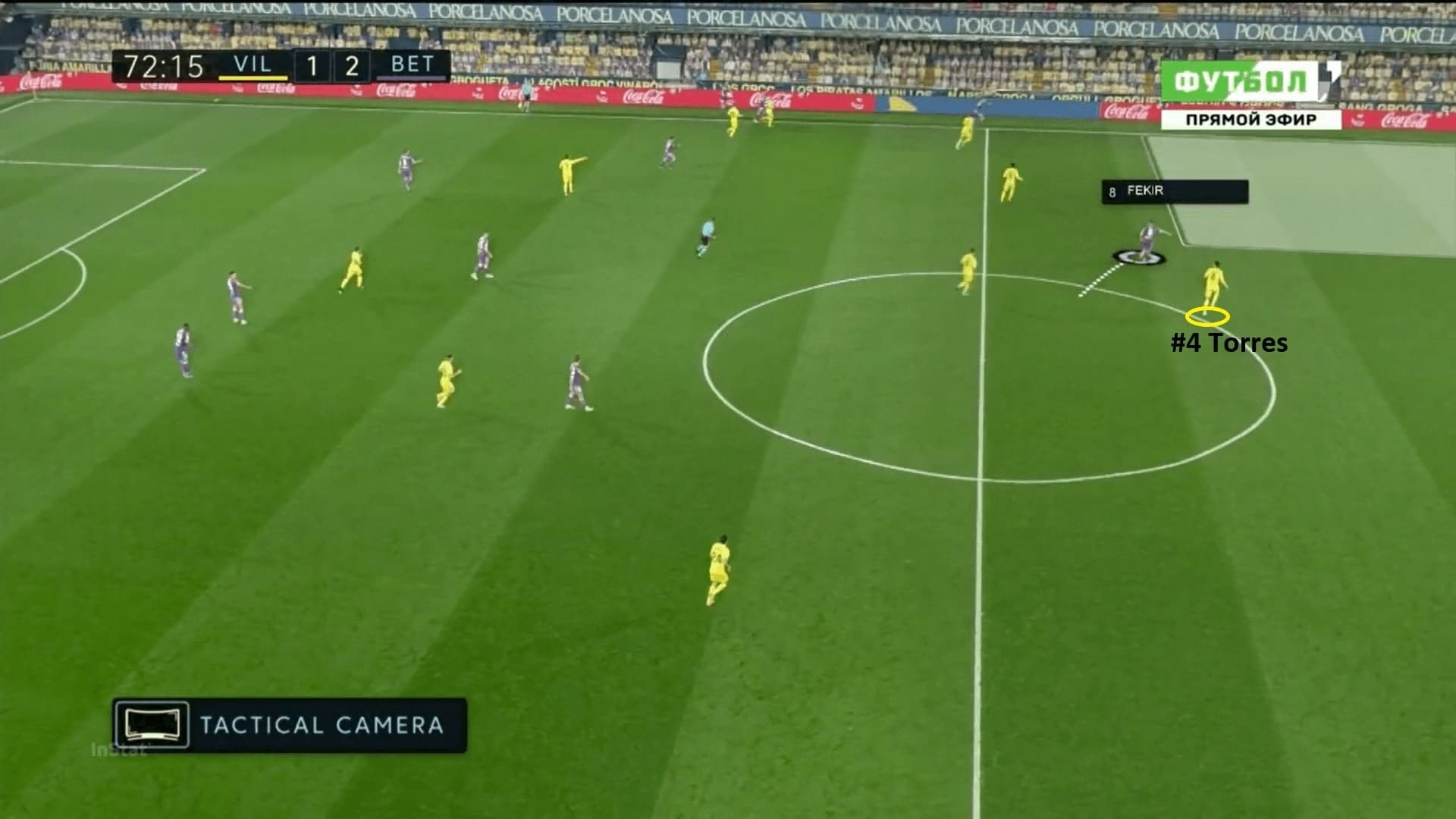
The first example here shows Torres trying to cover Fekir, with large spaces behind. He is the last defender on the pitch for Villarreal, and as the image shows, he could have easily played Fekir offside by stepping up. However, the Spaniard chose to chase him, allowing the Frenchman to create a dangerous situation which could have been easily avoided.
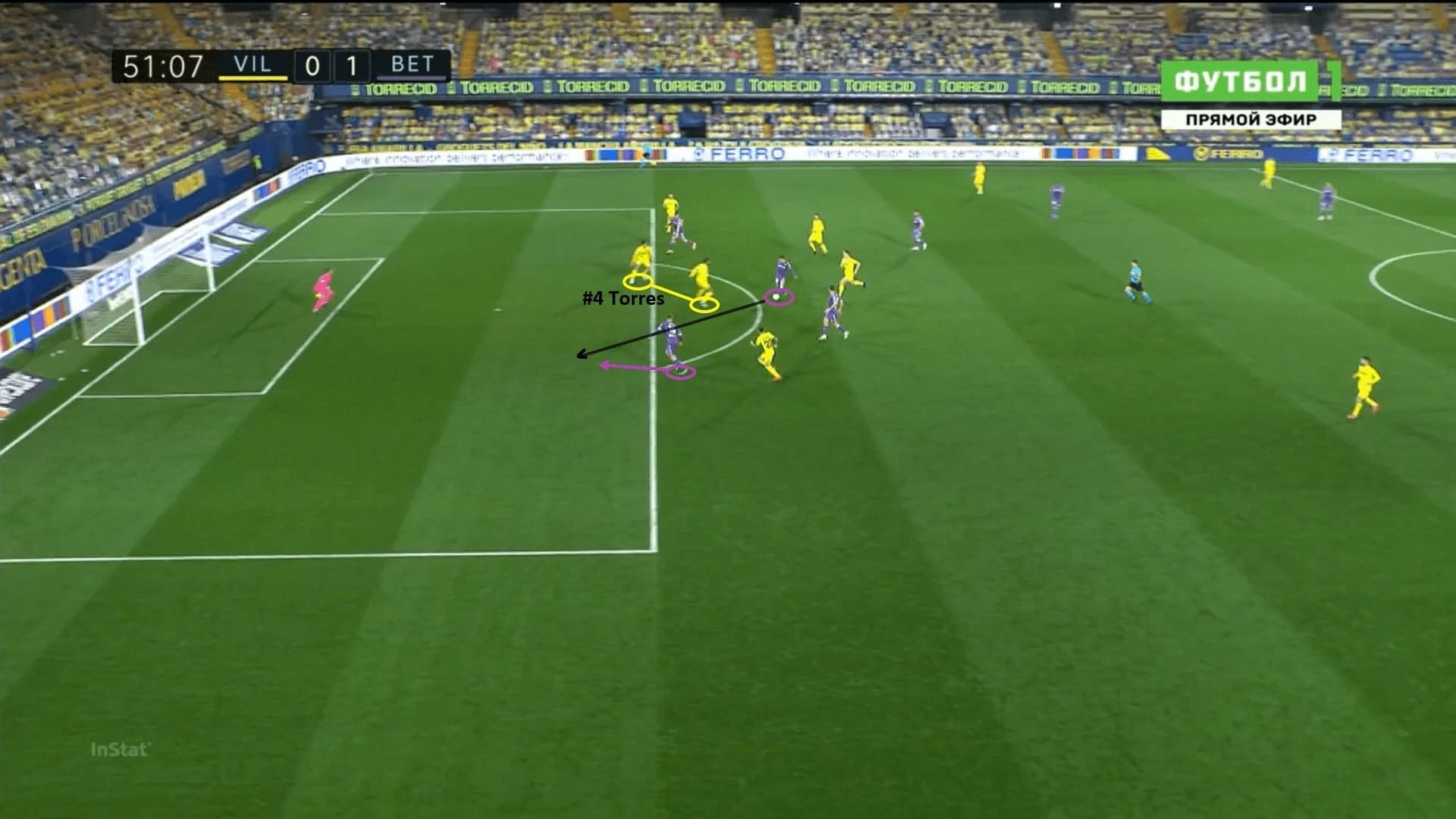
This image gives us another example of this issue in a different context. One of the most important elements of setting offside traps is communication and co-ordination with the rest of the defence – Torres seems to have issues with this as well.
Here, when his partner, Raul Albiol stepped up to set an offside trap, Torres surprisingly did the opposite. He dropped back to try and cover the space in behind in advance, but this decision meant that Albiol was out of position, opening up the diagonal passing lane for the far-side runner.
These examples have shown that Torres might not be a bad defender by himself, but from a collective perspective, he still needs to develop a relationship with his defensive partner, as well as the awareness to defend as a unit.
Final remarks
As we have shown in this analysis, Torres had the potential to become a world-class defender. He is an important part of Villarreal’s defence, while his ability to pass and organize the attack makes him a crucial part of Emery’s tactics. He has established himself as one of the regulars for Spain as well, and we can expect him to play alongside Ramos at the Euros.
However, Torres must improve his defending if he is to reach the top of the game. We have mentioned three key areas that need to be worked on: 1v1 defending, anticipation of movement in front of him, and the ability to play offside traps.





Comments